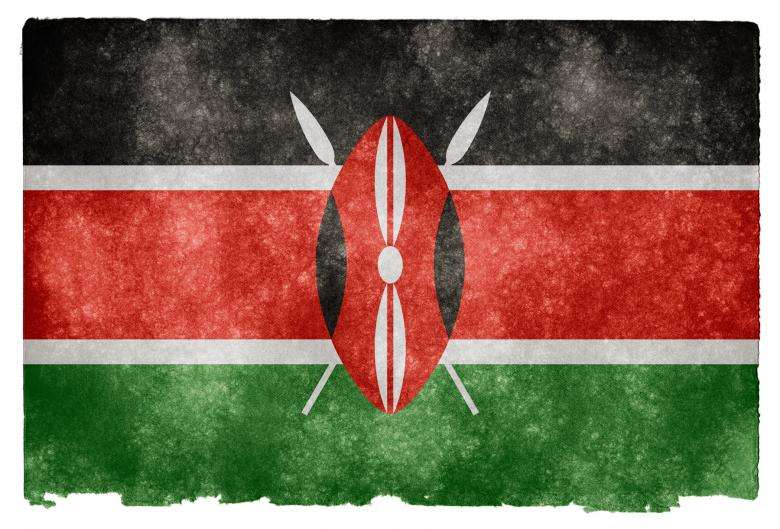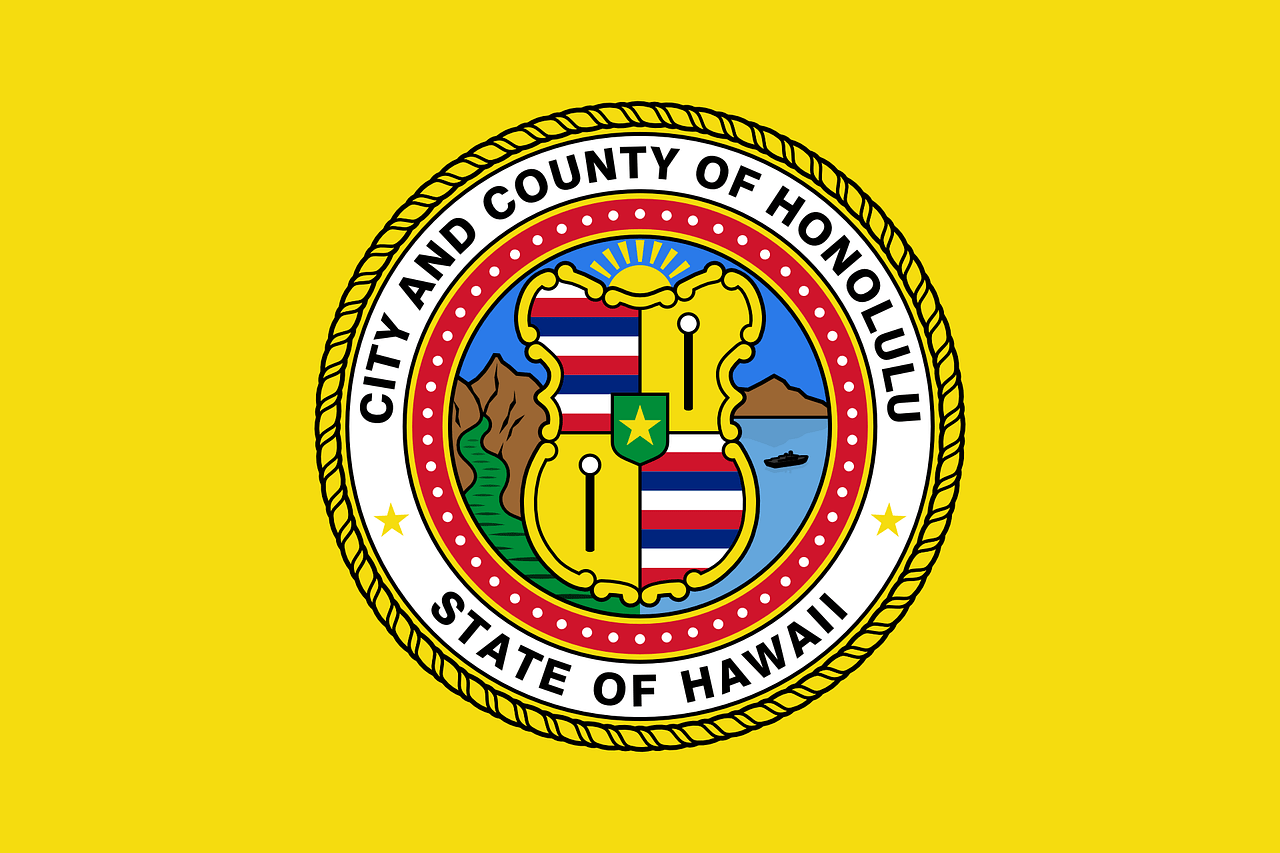The first Kenyan flag, which included a red lion and a British blue ensign, was adopted when Kenya became a protectorate of Great Britain in 1895. The flag didn’t change when the nation became a British Colony in 1920. German East Africa ceded a portion of Kenya to the British in 1893, and they renamed it the Witu Protectorate. The Great Britain flag was in the middle of a simple red field.
The Kenyan African National Union was established to pursue British independence. Later, the modern Kenyan flag was created based on the union’s colors. Kenya chose a new flag based on that of Kenya African National Union and was officially adopted on 12 December 1963, the year it gained independence. The Flag of Kenya is a tricolor with black, red, and green with two white edges imposed with a red, white and black, Maasai shield and two crossed spears.
The Kenyan flag is displayed on the banner of the Kenya African National Union (KANU), the political group that spearheaded the struggle for Kenya’s independence, which is black over red over green. Following independence, the shield and the white fimbriation, which stand for peace and togetherness, were added. The colors of the Kenyan flag have similar symbolic meanings to the Pan-African flag established in 1920 by the African Communities League and the Universal Negro Improvement Association.
Symbolism of Kenya Flag
Kenya’s flag has representations of the nation’s defense, peace, and togetherness. Red stands for the blood poured during the war for independence, black for the people of the Republic of Kenya, and green for the natural beauty and prosperity of the nation. The white fimbriation was then added to represent innocence, peace, purity, honesty, and purity. The two spears and the traditional Maasai shield in black, red, and white stand for the defense of everything described above. The flag of South Sudan has many hues and symbolic meanings with it.
Historical Flag of Kenya
Portugal, Oman, Britain, and Germany all had dominion over portions of Kenya’s coast from the 16th to the middle of the 20th century, but in the end, it was the country’s indigenous black population who decided on the images that are shown on the national flag. The Kenya African Union (KAU), the forerunner of the Kenya African National Union, was the dominant political force following World War II. On September 3, 1951, the party unveiled its first flag, which was red and black with a shield and arrow in the center.
The backdrop was changed the next year to three equally spaced horizontal black, red, and green stripes, with a white shield and crossed spear and arrow in the center, along with the initials ‘KAU’. The red represented the common blood of all humanity, while the black represented the indigenous population. The guns served as a reminder that organized struggle served as the foundation for future self-government, while green represented the country’s bountiful soil.
After Independence from Britain in 1963, the current national flag became official. To distinguish the red from the black and green in the party flag’s horizontal stripes, white fimbriations (thin borders) were added. The shield suggested the traditional ways of living in Kenya by being expanded and designed after those carried by the Maasai tribe. White stood for harmony and serenity, while crimson symbolized the fight for independence. The original design’s arrow and spear were replaced by two spears.
The Coat of Arms of Kenya
The national flag of Kenya and a cockerel grasping an ax are displayed on a Maasai shield that was approved as the country’s coat of arms in 1963. The shield is being held up by two lions, who are carrying crossed spears in their hands. A banner with the words ‘’LET’S PULL TOGETHER” and a silhouette of Mount Kenya is shown underneath the shield.
The Flag of the President of Kenya
The Flag of the President of Kenya has changed over the years. The Maasai shield and crossed spears were shown in some way on each flag.
The national flag with the national coat of arms in the center appears on the first flag, which was established in 1963. The second flag had a simple white field with a laurel wreath, the third had a green field with a red cockerel, and the fourth had a dark blue field with a golden cockerel.
To commemorate President Uhuru Kenyatta’s victory in 2013, a new presidential standard was adopted. A white dove, a Maasai shield, and crossed spears are on a blue background.
Kenya’s Military Flags
In Kenyan Military Flags, the National flag features in the top left-hand corner.
The Defense Forces Flag features a red-light blue- blue horizontal tricolor with a blue anchor, crossed guns, golden eagle emblem with the banner stating, “KENYA ARMED FORCES.”
The Kenyan Air Force Flag has a light blue background with a roundel in the right corner that is black-red-green.
The Naval Ensign of Kenya features a white field with a red anchor and the Presidential Color of the Kenyan Navy features a red anchor behind the National Coat of Arms.
About Kenya
Kenya, an East African nation known for its beautiful landscapes and sizable wildlife preserves.
Kenya is bounded to the north by South Sudan and Ethiopia, to the east by Somalia and the Indian Ocean, to the south by Tanzania, to the west by Lake Victoria and Uganda, and to the northwest by the Equator and longitude 38° E. The Indian Ocean coast of the continent served as historically significant ports for the entry of goods from Asian and Arabian traders. Cities that are mostly Muslim Swahili, such as Mombasa, a historic centre that has made significant contributions to the nation's musical and culinary legacy are located along this coast, which is home to some of Africa’s best beaches. The populated highlands in the interior are home to a variety of animals, such as lions, elephants, cheetahs, rhinoceroses, and hippopotamuses. The region was also known for its tea plantations, which were a major source of income for the British Empire during its colonial era. While a small portion of the north is desert and semidesert, the western provinces of Kenya, which are characterized by lakes and rivers, are forested. Numerous European and North American tourists flock to Kenya each year, and the tourism industry plays a significant role in the country’s economy.
Nairobi, the capital of Kenya, is a large city that, like many other African metropolises, is a study in contrasts, with contemporary skyscrapers gazing out over extensive shantytowns in the distance, many of which are sheltering refugees from nearby civil conflicts. While the tents and hastily constructed shacks that ring the city tend to be organized tribally and even locally, in some cases whole rural villages have relocated to the promising cities, older prosperous neighborhoods tend to be ethnically mixed and well served by utilities and other amenities.
Given the country’s experience during the struggle for independence, Kenya has a rich tradition of oral and written literature, which includes many fables that speak to the virtues of tenacity and perseverance, which are significant and universal values. Additionally, musical and creative expression have a long history in Kenya.
Kenya’s diverse population is well understood by outsiders in large part due to the British colonial government’s welcoming attitude toward research. For many years, anthropologists and other social scientists have studied the Maasai, Luhya, Luo, Kalenjin, and Kikuyu peoples, to mention just a few. Immigrants from different European and Asian countries multifold the ethnic variety of the country. Kenyans are proud of their unique cultures and traditions, but they also understand the value of national unity. Since Kenya’s independence, the government has promoted the value of ‘Harambee’ which is Swahili for ‘pulling together’.
By: Jasleen Kaur



